UPSC Prelims Previous Year Questions 2019: Geography | Geography for UPSC CSE PDF Download
Q1: On 21st June, the Sun
(a) does not set below the horizon at the Arctic Circle
(b) does not set below the horizon at Antarctic Circle
(c) shines vertically overhead at noon on the Equator
(d) shines vertically overhead at the Tropic of Capricorn
 View Answer
View Answer 
Ans: (a)
- 21st June is the longest day of the year as countries lying to the north of the equator, including India, witness ‘Summer Solstice’.The ‘summer solstice’ occurs exactly when the earth’s axial tilt is most inclined towards the sun at its maximum of 23 degrees 26’.During ‘summer solstice’, the Northern Hemisphere witnesses its longest day of the year while the Southern Hemisphere sees its shortest day.
- On the June solstice, the Earth’s North Pole is at its maximum tilt toward the sun. At this time, the sun appears directly overhead at 23.5 degrees north latitude, along the Tropic of Cancer.
- Around the Arctic Circle, the location of sunrise and sunset start to converge in the northern sky, until eventually the sun never sinks below the horizon. Hence, the appearance of the midnight sun.
Q2: Consider the following pairs:
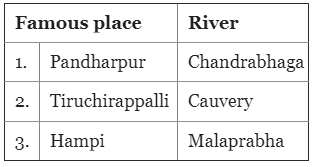
Which of the pairs given above are correctly matched?
(a) 1 and 2 only
(b) 2 and 3 only
(c) 1 and 3 only
(d) 1, 2 and 3
 View Answer
View Answer 
Ans: (a)
- Pandharpur is a holy place of Shri.Vitthal and Shri.Rukmini. It is also known as the Southern Kashi of India and Kuldaivat of Maharashtra State. The Chandrabhaga (Bhima) river flows through the City.Tiruchirappalli, situated on the banks of the river Cauvery is the fourth largest city in Tamil Nadu. It was a citadel of the early Cholas which later fell to the Pallavas.
- Hampi is a UNESCO World Heritage Site in India located near Hospet town in the Karnataka state, on south bank of Tungabhadra river.
Q3: Consider the following States:
- Chhattisgarh
- Madhya Pradesh
- Maharashtra
- Odisha
With reference to the States mentioned above, in terms of percentage of forest cover to the total area of State, which one of the following is the correct ascending order?
(a) 2-3-1-4
(b) 2-3-4-1
(c) 3-2-4-1
(d) 3-2-1-4
 View Answer
View Answer 
Ans: (c)
India state of forest report 2017
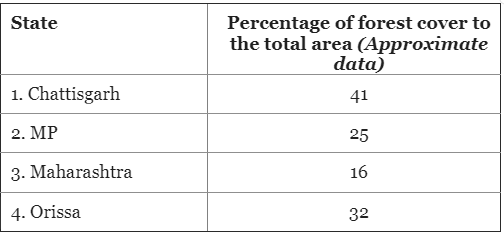
Hence, correct ascending order- (3-2-4-1)
Q4: Consider the following pairs:
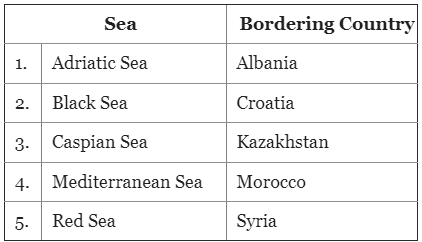
Which of the pairs given above are correctly matched?
(a) 1, 2 and 4 only
(b) 1, 3 and 4 only
(c) 2 and 5 only
(d) 1, 2, 3, 4 and 5
 View Answer
View Answer 
Ans: (b)
- The Adriatic Sea is a part of the Mediterranean Sea positioned between the eastern coastline of Italy, and countries of the Balkan Peninsula, from Slovenia, South through Croatia, Montenegro, and to Albania. Hence, pair 1 is correctly matched.
- The Black Sea is an inland sea located between far-southeastern Europe and the far- western edges of the continent of Asia and the country of Turkey. It's bordered by Turkey, and by Bulgaria, Romania, Ukraine, Russia and Georgia. Hence, pair 2 is not correctly matched. this rules out options a, c and d, leaving the correct answer to be option B through elimination method.
- Caspian Sea is an enclosed body of water between Asia and Europe. It is bordered by Iran, Turkmenistan, Kazakhstan, Azerbaijan, Russia, Morocco’s Mediterranean coast represents the westernmost edge of the Northern African coast. The coastline features the Strait of Gibraltar that marks the link between the Mediterranean Sea and the Atlantic Ocean.
There are six countries (Saudi Arabia, Yemen, Egypt, Sudan, Eritrea, and Djibouti) bordering the Red Sea.
Q5: Consider the following pairs
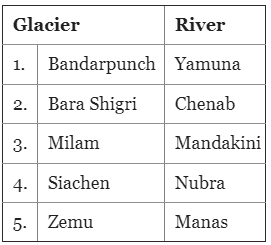
Which of the pairs correctly matched?
(a) 1, 2 and 4
(b) 1, 3 and 4
(c) 2 and 5
(d) 3 and 5
 View Answer
View Answer 
Ans: (a)
- An important glacier of Yamuna river basin is Bandarpunch Glacier in the Garhwal division of the Himalayas. It is 12 km long situated on the Northern slopes of Bandarpunch West, Khatling peak and Bandarpunch peak the glacier is formed by three cirque glaciers and then join the river of Yamuna. Hence, 1 is correctly matched
- Bara Shigri is the largest glacier located in Lahaul Spiti region in Chandra Valley, Himachal Pradesh. It is a 30-km long glacier, the second longest glacier in the Himalayas after Gangotri. It flows northwards and feeds the Chenab river. Hence, Statement 2 is correct.
- Milam Glacier in Munsiyari, Pithoragarh district, Uttarakhand is the source of Gori Ganga River and not of Mandakini River. Gori Ganga is also an important tributary of Kali River. Hence, Statement 3 is not correct.
- At an altitude of roughly 5,400 meters (17,700 feet), the Siachen Glacier in Kashmir is a forbidding place. At much lower altitudes, the glacier’s impact is benign: it is the source of the Nubra River, a tributary of the Indus River flowing into Pakistan and the Arabian Sea. Hence, Statement 4 is correct.
- The Zemu glacier is the largest in the Eastern Himalayas in Sikkim. It is at the base of the Kanchendzonga and is one of the sources for the Teesta not Manas river. Teesta is a tributary of the Brahmaputra.Hence, Statement 5 is not correct.
Q6: What is common to the places known as Aliyar, Isapur and Kangsabati?
(a) Recently discovered uranium deposits
(b) Tropical rain forests
(c) Underground cave systems
(d) Water reservoirs
 View Answer
View Answer 
Ans: (d)
Aliyar (Tamil Nadu) Isapur (Maharashtra) and Kangsabati (West Bengal) are water reservoirs, where water level reached much below the normal capacity.
Q7: Why are dewdrops not formed on a cloudy night?
(a) Clouds absorb the radiation released from the Earth’s surface.
(b) Clouds reflect back the Earth’s radiation.
(c) The Earth’s surface would have low temperature on cloudy nights.
(d) Clouds deflect the blowing wind to ground level.
 View Answer
View Answer 
Ans: (b)
- Dew is a type of precipitation where water droplets form on the ground, or on objects near the ground in a process called condensation of moisture. The favorable weather elements for dew include clear skies, light wind, decent soil moisture, and low night-time dew point depressions.
- Dew forms when the temperature becomes equal to the dew point. This often happens first at ground level for two reasons. First, longwave emission causes the earth's surface to cool at night.Cloud cover prevent this from happening as it reflect's earth's radiation.
- Condensation requires the temperature to decrease to the dew point. Second, the soil is often the moisture source for the dew. Warm and moist soils will help with the formation of dew as the soil cools overnight.
Q8: With reference to the management of minor minerals in India, consider the following statements:
- Sand is a ‘minor mineral’ according to the prevailing law in the country.
- State Governments have the power to grant mining leases of minor minerals, but the powers regarding the formation of rules related to the grant of minor minerals lie with the Central Government.
- Stale Governments have the power to frame rules to prevent illegal mining of minor minerals.
Which of the statements given above is/are correct?
(a) 1 and 3 only
(b) 2 and 3 only
(c) 3 only
(d) 1, 2 and 3
 View Answer
View Answer 
Ans: (a)
Sand is a minor mineral, as defined under section 3(e) of the Mines and Minerals (Development and Regulation) Act, 1957 (MMDR Act). Hence statement 1 is correct. Section 15 of the MMDR Act empowers state governments to make rules for regulating the grant of mineral concessions in respect of minor minerals and for purposes connected therewith. The regulation of grant of mineral concessions for minor minerals is, therefore, within the legislative and administrative domain of the state governments. Under the power granted to them by section 15 of the MMDR Act, State Governments have framed their own minor minerals concession rules. Hence statement 2 in incorrect. section 23C of theMMDR Act, 1957 empowers state governments to frame rules to prevent illegal mining, transportation and storage of mineralsand for purposes connected therewith. Control of illegal mining is, therefore, under the legislative and administrative jurisdiction of state governments. Hence statement 3 is correct.
Q9: With reference to the cultivation of Kharif crops in India in the last five years, consider the following statements:
- Area under rice cultivation is the highest.
- Area under the cultivation of jowar is more than that of oilseeds.
- Area of cotton cultivation is more than that of sugarcane.
- Area under sugarcane cultivation has steadily decreased.
Which of the statements given above are correct?
(a) 1 and 3 only
(b) 2, 3 and 4 only
(c) 2 and 4 only
(d) 1, 2, 3 and 4
 View Answer
View Answer 
Ans: (a)
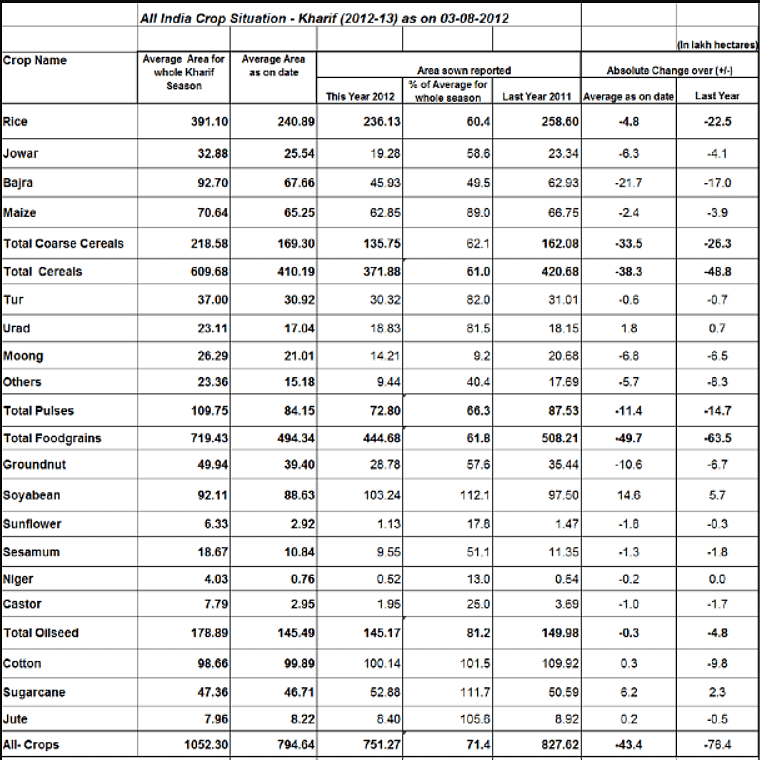
|
175 videos|619 docs|192 tests
|
FAQs on UPSC Prelims Previous Year Questions 2019: Geography - Geography for UPSC CSE
| 1. What are the topics covered in the UPSC Prelims Geography exam? |  |
| 2. How can I prepare for the UPSC Prelims Geography exam? |  |
| 3. What are some important geographical concepts to focus on for the UPSC Prelims exam? |  |
| 4. Are map-based questions asked in the UPSC Prelims Geography exam? |  |
| 5. How much weightage does the Geography section carry in the UPSC Prelims exam? |  |














